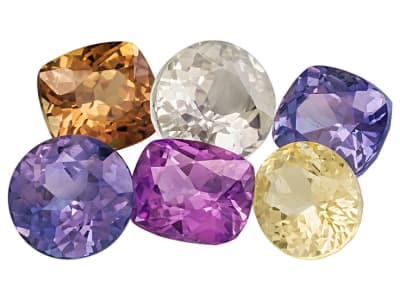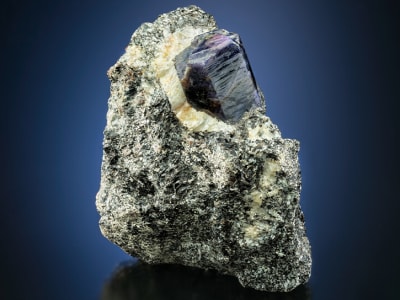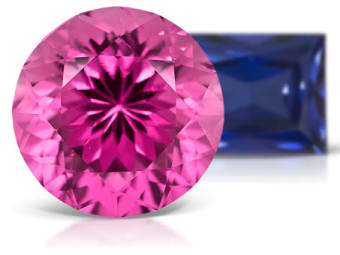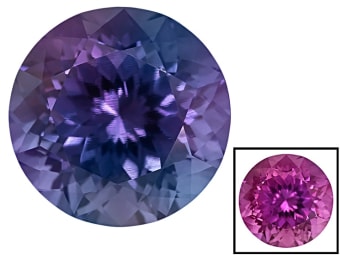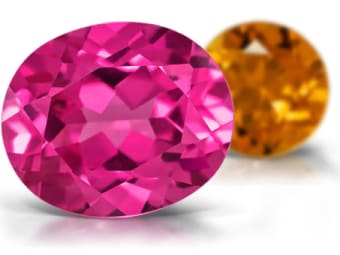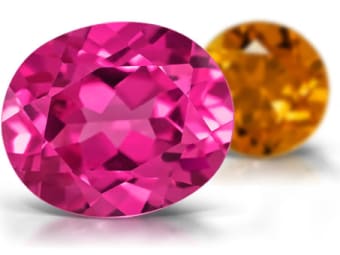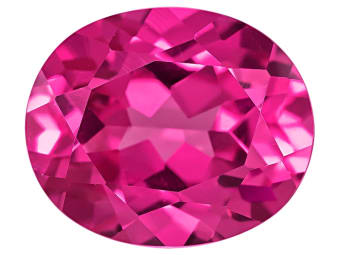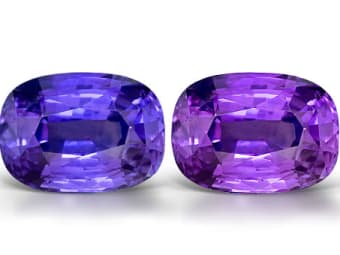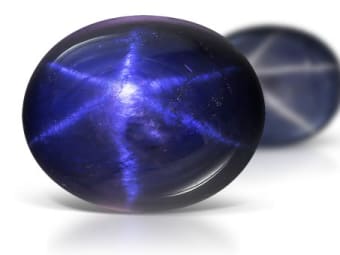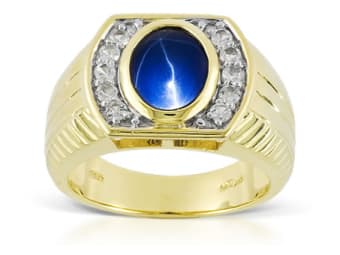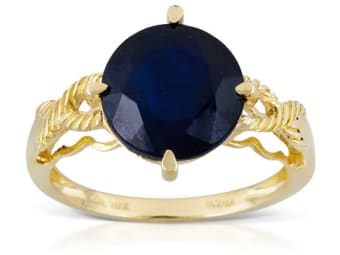When many people think of sapphire, they envision a rich blue gemstone. When the term sapphire is used alone it does refer to the blue variety of corundum. All other colors of sapphires must be described with its color modifier, for example pink sapphire. The other colors of sapphire are often called fancy sapphire and they come in every color of the rainbow except red. Red corundum is known as ruby. Sapphire is the September birthstone. Sapphire is a 9 on the mohs hardness scale and its beauty, strength and durability are perfect mixture for use in jewelry.
General Information
Tolerance:(+0.009/-0.005)
LWUV: Inert to weak red to orange
Sapphire Colors
-
 Bi-color
Bi-color -
 Black
Black -
 Blue
Blue -
 Blue
Blue -
 Brown
Brown -
 Colorless
Colorless -
 Gray
Gray -
 Green
Green -
 Multi-color
Multi-color -
 Orange
Orange -
 Pink
Pink -
 Purple
Purple -
 Red
Red -
 White
White -
 Yellow
Yellow
Sapphire Spectra
We acknowledge the significant scientific contributions of John S Harris, FGA to the study of gemstone spectra and with deep appreciation to him, acknowledges the use of his images and related notes about gemstones and their spectra in the educational materials on this website.
Countries of Origin
Tanzania, United Republic Of; Myanmar; Afghanistan; Russian Federation; Viet Nam; Cambodia; United States of America; Madagascar; Thailand; Mozambique; Pakistan; Unknown; Malawi; China; Brazil; Nigeria; Sri Lanka; Belize; Zambia; Kenya; Switzerland; French Polynesia; India; Norway; Namibia; South Africa; Australia; Ethiopia
History
Sister stone to the ruby, most people think blue when they think sapphire. Blue is sapphire's best-known color. When sapphire is blue, it reminds us of the sky, the sea and eternity. But sapphire isn't always blue - we find sapphire in every color in, and under, the rainbow. One of the world's most prized stones is the orange sapphire known as padparadscha. It's lotus-flower color offers up fiery beauty. There are cool green sapphires, warm golden sapphires, pretty pink sapphires... in the world of the sapphire there's a color that's right for you. There is also a sapphire that changes color when moved from natural to incandescent light. It's color-change sapphire and it can be glorious! It can be a brilliant color change from blue to a rich purple or it may be a subtler change. Whether brilliant or subtle, the color-change of sapphire is compelling. Sapphire is corundum and a 9 on the hardness scale. It's wearable and wonderful. Sapphire is September's birthstone.
Care
Untreated and heated sapphires just need normal care. Avoid recutting or chipping beryllium lattice or surface diffused stones. Avoid common household chemicals, steam cleaners, ultrasonic cleaners and a jeweler’s torch with lead glass filled, dyed or oiled/resin filled stones.
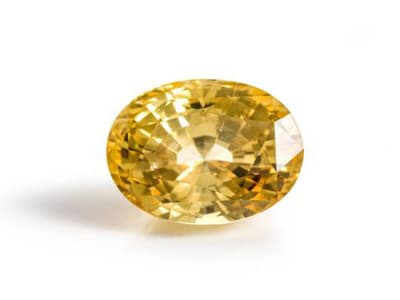
More About Sapphire
Sapphire is steeped in history and lore. It was believed that sapphire could protect kings from harm and envy; it is a symbol of trust, faithfulness, nobility, and royalty. The ancient Persians believed sapphire to be a chip off the pedestal on which the earth balances. Our favorite is the belief that sapphire can make a stupid man wise and transform a bad-tempered man into a good-tempered one. Why not follow the trend of some well-known royals and choose an engagement ring of sapphire? The colors are appealing, the folklore delightful and you'll be in very fine company!
Creation Method
Lab Created Hydrothermal
Hydrothermally grown synthetic sapphires crystallize slowly out of a solution (a mix of water and dissolved elements) that has been exposed to heat and pressure similar to the conditions on Earth under which the natural gem mineral grows. Synthetic gems have the same chemical, optical, and physical properties of their natural counterparts, but are a more cost-effective alternative to a natural gem.
LWUV: Inert
Lab Created Color-change
The flame fusion process for creating gems, also called the Verneuil process, is the most affordable and common synthesis method for producing corundum (ruby and sapphire) and spinel. Powdered chemicals (the building blocks of the gem) are dropped through a high-temperature flame. The molten powder repeatedly falls from the flame onto a rotating pedestal, creating a synthetic crystal,called a boule, which can later be faceted into a gemstone. Synthetic gems have the same chemical, optical, and physical properties of their natural counterparts, but are a more cost-effective alternative to a natural gem.
LWUV: moderate orange to red
Lab Created Floating Zone
One method of creating synthetic sapphire is called floating zone. In this method of gem synthesis, originally developed by engineers to create super pure silicon, a sintered rod of powdered material, comprised of elements necessary for the gem to grow, is heated with infrared radiation in a vacuum while the ends of the rod are rotated in opposite directions. Since all impurities including air are removed during crystallization, very clean crystals can form.
LWUV: strong red
Lab Created Czochralski
Synthetic sapphire can be created in many ways, one of which is called the Czochralski method. During this process, the various elements that make up sapphire are melted in a platinum crucible. A small gem crystal (called a seed) attached to a rod is then dipped into the melt and slowly pulled away as the crystal grows around the seed. For this reason, the Czochralski method is also known as crystal pulling. Synthetic gems have the same chemical, optical, and physical properties of their natural counterparts, but are a more cost-effective alternative to a natural gem.
LWUV: Variable
Lab Created Flame Fusion
The flame fusion process for creating gems, also called the Verneuil process, is the most affordable and common synthesis method for producing corundum (ruby and sapphire) and spinel. Powdered chemicals (the building blocks of the gem) are dropped through a high-temperature flame. The molten powder repeatedly falls from the flame onto a rotating pedestal, creating a synthetic crystal, called a boule, which can later be faceted into a gemstone. Synthetic gems have the same chemical, optical, and physical properties of their natural counterparts, but are a more cost-effective alternative to a natural gem.
LWUV: inert
Lab Created Flux
Synthetic sapphire can be created in many ways, one of which is called flux growth. During the flux growth process, flux, a substance that reduces the melting point of surrounding material, is combined, in a metal-lined crucible, with the elements that make up a specific gem mineral. The crucible is heated until its contents are liquid and then it is allowed to cool very slowly. As cooling continues, the gem mineral crystallizes from the solution. Flux grown synthetic gems can take up to a year to grow to a facetable size, but the exceptional clarity of these gems is well worth the wait! Synthetic gems have the same chemical, optical, and physical properties of their natural counterparts, but are a more cost-effective alternative to a natural gem.
LWUV: inert
Optical Phenomena
Color Change
While color change sapphires come from a variety of locations, the gem gravels of Tanzania are the main source. Color change sapphires present gem lovers with an opportunity to own the rare and stunning color change effect in a gem other than alexandrite, garnet, spinel, tourmaline or diaspore. While the colors tend to vary depending on locale, in general they change from blue to purple. You can observe color change in this gem by viewing it interchangeably in natural and incandescent light.
LWUV: Inert
Lab Created Star
Synthetic star sapphire exhibits the optical phenomenon called asterism, a star-like pattern created on the surface of a gemstone when light encounters parallel fibrous, or needle-like, inclusions within its crystal structure. Light that strikes the inclusions within the gem reflects off of the inclusions, creating a narrow band of light. When two or more intersecting bands appear, a star pattern is formed. The flame fusion process for creating gems, also called the Verneuil process, is the most affordable and common synthesis method for producing corundum (ruby and sapphire) and spinel. Powdered chemicals (the building blocks of the gem) are dropped through a high-temperature flame. The molten powder repeatedly falls from the flame onto a rotating pedestal, creating a synthetic crystal, called a boule, which can later be faceted into a gemstone. Synthetic gems have the same chemical, optical, and physical properties of their natural counterparts, but are a more cost-effective alternative to a natural gem.
LWUV: Inert
Star
Star sapphire exhibits the optical phenomenon called asterism, a star-like pattern created on the surface of a gemstone when light encounters parallel fibrous, or needle-like, inclusions within its crystal structure. Light that strikes the inclusions within the gem reflects off of the inclusions, creating a narrow band of light. When two or more intersecting bands appear, a star pattern is formed. Depending on the crystal, the star typically has six rays, but on occasion, twelve rays.
LWUV: Inert to strong red
Cat's-Eye
The term cat's eye, or chatoyancy, is used to describe a phenomenal optical property in gemstones, in this case sapphire. The effect, when present, appears as a bright, narrow slit similar to the pupils in the eyes of your favorite feline. This phenomenon is caused by parallel fibrous or needle-like inclusions that interfere with the passage of light through the crystal, scattering and reflecting light back to the viewer as a thin line.
LWUV: Blue: Inert; possibly red to orange Pink: strong orange-red Orange: maybe strong orange red Yellow: inert to moderate orange red to orange-yellow Green: inert Violet: inert to moderate to strong red Colorless: inert to moderate red to orange Brown: usually inert, maybe weak red Black: inert
Enhancement
Cobalt-Lead Glass Filled
Cobalt-lead glass filled sapphire has been filled through a process similar to "infilling" using lead glass. Performed at low heat, this is a less durable treatment and should be treated gently, avoiding household and professional chemicals. This treatment, which uses cobalt-colored lead glass, improves clarity, color, and may add weight through the filling of voids and fissures.
LWUV: inert
